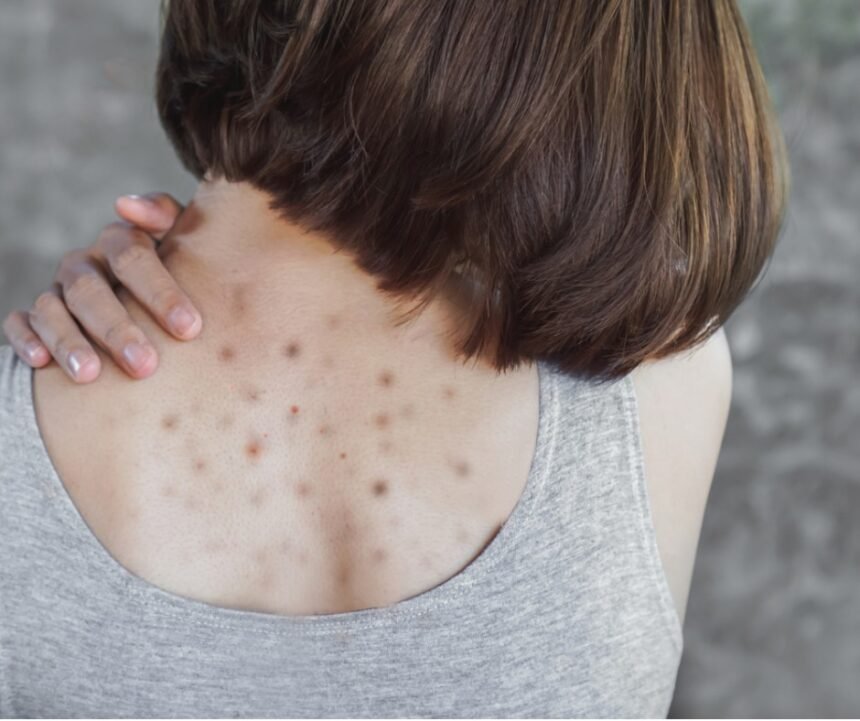Additionally, the skin on the nose can be oilier, making it more susceptible to acne breakouts.
Various factors can trigger nose acne, including diet, stress, certain medications, or underlying health issues. However, inadequate hygiene is the most common cause. Incorporating Tea Tree Oil into your skincare routine can be a gentle yet effective treatment for acne.
You can also consider using products containing sodium sulfacetamide and sulfur to prevent bacterial growth on the skin. In severe cases, seeking advice from a dermatologist is advisable.
5.
Around the mouth
[wpdiscuz-feedback id=”n9fay8v4ee” question=”Please leave a feedback on this” opened=”1″] [/wpdiscuz-feedback]
[/wpdiscuz-feedback]
Acne near your mouth can arise from skin irritation or frequent contact with objects such as cell phones, helmet straps, or musical instruments. The use of certain cosmetics or facial products, hormonal fluctuations, and genetic factors can also trigger it. If you are dealing with recurring mouth acne, it’s advisable to seek the guidance of a dermatologist who can provide suitable treatment options.
However, prevention is often the best approach. Establishing a daily skincare routine that includes gentle cleansing with a mild cleanser, choosing makeup labeled as “non-comedogenic,” and opting for oil-free products while refraining from touching your face can go a long way in preventing mouth acne outbreaks.
6.
Legs
[wpdiscuz-feedback id=”oojvw2f8v3″ question=”Please leave a feedback on this” opened=”1″] [/wpdiscuz-feedback]
[/wpdiscuz-feedback]
Leg acne primarily occurs when bacteria, sebum (natural skin oil), and dead skin cells become trapped in hair follicles, leading to pore blockages and subsequent inflammation. This issue is typically attributed to physical factors, such as friction from athletic equipment or overly snug clothing. However, it’s essential to exercise caution, as leg acne can sometimes be mistaken for other skin conditions like folliculitis, eczema, or keratosis pilaris.
If you experience itchiness or pain, it’s advisable to consult a medical professional for proper diagnosis and professional treatment.
7. Jaw and neck
[wpdiscuz-feedback id=”uk47xsyp2t” question=”Please leave a feedback on this” opened=”1″] [/wpdiscuz-feedback]
[/wpdiscuz-feedback]
While acne is often associated with hormonal imbalances, it’s not exclusively driven by hormones.
When specific hormone levels, particularly androgens, change, it can contribute to the onset of adult acne. Notably, areas like the jaw and neck can indicate hormonal fluctuations. Hormonal variations during menstrual cycles are entirely normal, as are shifts resulting from medication usage like birth control.
In severe cases, hormonal acne may be linked to an underlying medical condition. However, in most instances, adopting a skincare routine that includes non-comedogenic cleansers, moisturizers, and targeted acne treatments can effectively address the issue. Additionally, practicing sun safety and using sunscreen appropriately can significantly affect acne management.
8. Shoulders
[wpdiscuz-feedback id=”yn657k7sg7″ question=”Please leave a feedback on this” opened=”1″] [/wpdiscuz-feedback]
[/wpdiscuz-feedback]
Shoulder acne is a skin issue that can crop up due to various factors. It usually starts when there’s an excess production of sebum, a buildup of dead skin cells, or other debris that gets clogged up in your pores, causing them to become blocked.
But there are some handy steps you can take to help prevent new acne flare-ups. One of the simplest yet often overlooked practices is ensuring you drink adequate water daily. Another vital consideration in your skincare routine, especially when dealing with acne, is using a sun-protected moisturizer.
Additionally, if you’re prone to shoulder acne, mainly due to factors like friction from clothing, it’s a good idea to opt for loose-fitting and breathable garments. Our well-being deserves our utmost attention, and interestingly, our bodies serve as vigilant messengers, sending us signals when something isn’t right. Still, these subtle cues sometimes fly under our radar.





